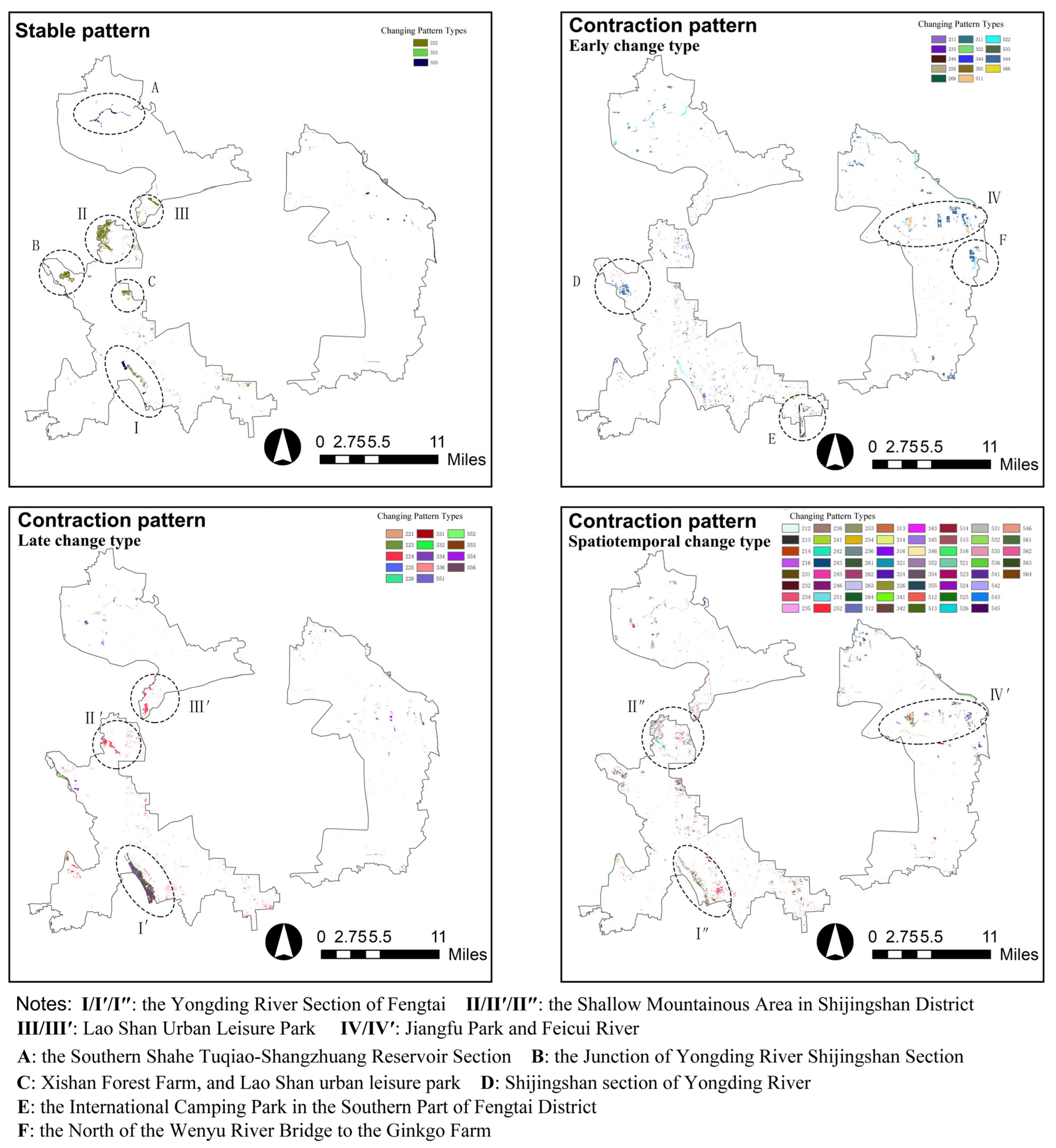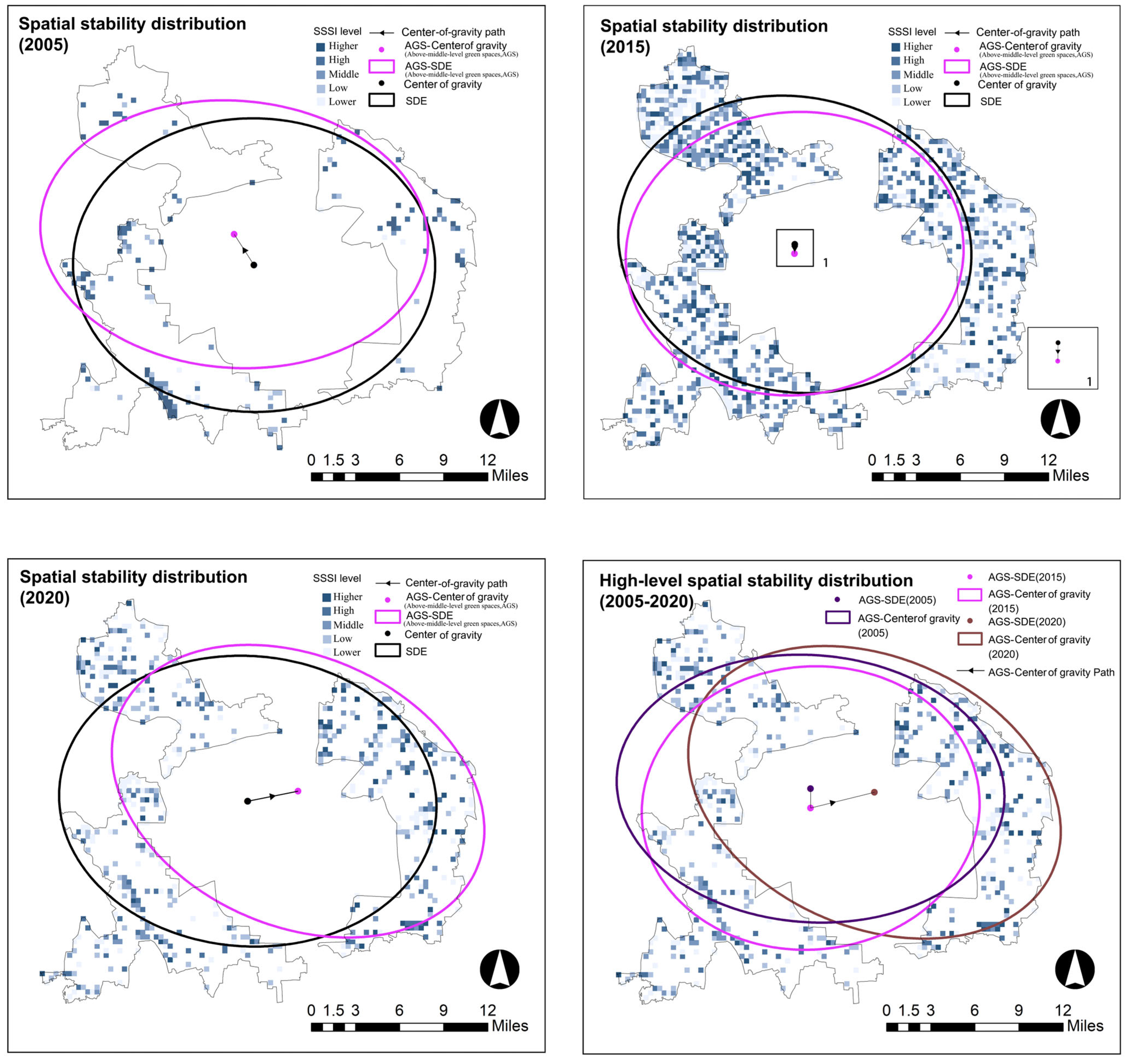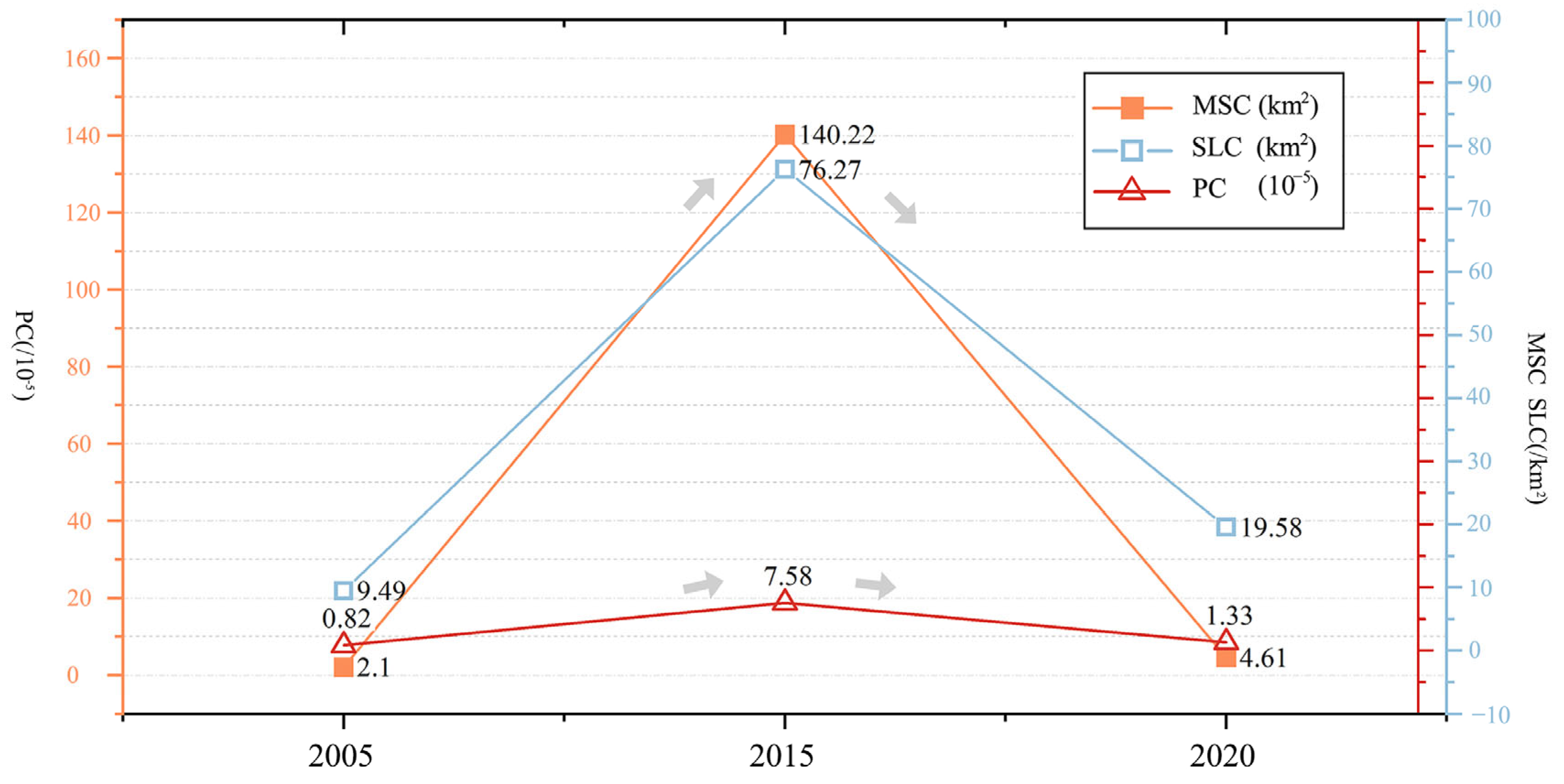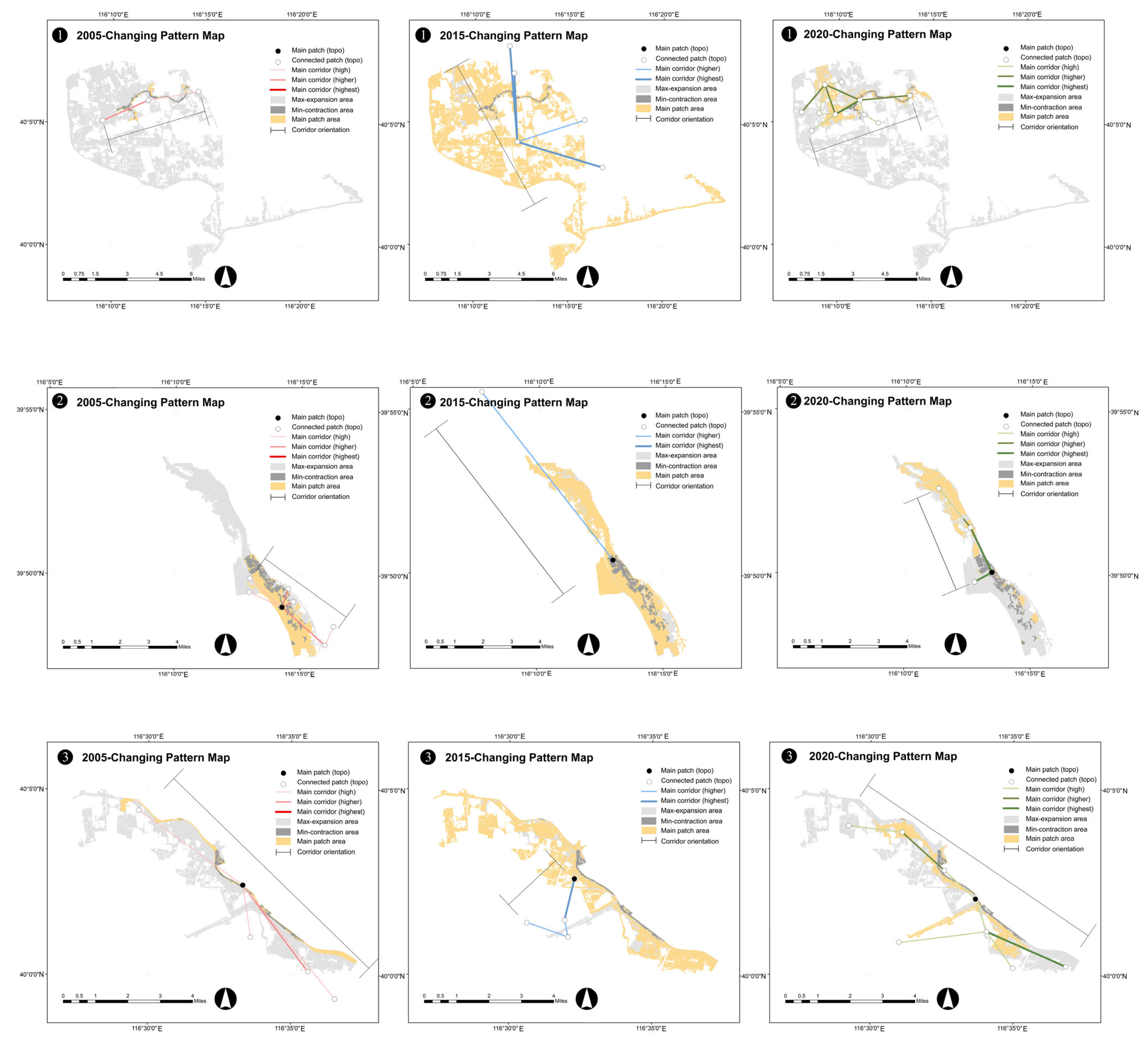Study on the Spatiotemporal Evolution of the “Contraction–Expansion” Change of the Boundary Area between Two Green Belts in Beijing Based on a Multi-Index System
Abstract
:1. Introduction
2. Concept of “Contraction–Expansion” Evolution
3. Data Source and Processing
4. Research Area
5. Construction of a Multidimensional Indicator System
5.1. Change in Quantity Level—Area Change under “Contraction–Expansion” Mode
5.2. Space Characteristics Level—Morphological Features and Spatial Distribution
5.3. Connectivity Level—Global and Local Level of Connectivity
6. Results
6.1. Analysis of Green Space Land-Use Area from 2005–2020
6.2. Analysis of the Multiple Index System of Green Spaces from 2005 to 2020
6.2.1. Analysis of the Area Changes in the “Contraction–Expansion” Pattern of Green Space
Stable and Contraction Patterns of Green Space
Expansion Patterns of Green Space
6.2.2. Analysis of Green Space Feature Distribution
Characteristics of Spatially Aggregated Effect
Characteristics of Space Stability
6.2.3. Analysis of Green Space Connectivity Level
7. Discussion
8. Conclusions
Author Contributions
Funding
Data Availability Statement
Conflicts of Interest
References
- Islam, M.N.; Rahman, K.-S.; Bahar, M.M.; Habib, M.A.; Ando, K.; Hattori, N. Pollution attenuation by roadside greenbelt in and around urban areas. Urban For. Urban Green. 2012, 11, 460–464. [Google Scholar] [CrossRef]
- Kowarik, I. The “Green Belt Berlin”: Establishing a greenway where the Berlin Wall once stood by integrating ecological, social and cultural approaches. Landsc. Urban Plan. 2019, 184, 12–22. [Google Scholar] [CrossRef]
- Pathak, V.; Tripathi, B.D.; Mishra, V.K. Evaluation of Anticipated Performance Index of some tree species for green belt development to mitigate traffic generated noise. Urban For. Urban Green. 2011, 10, 61–66. [Google Scholar] [CrossRef]
- Yang, J.; Jinxing, Z. The failure and success of greenbelt program in Beijing. Urban For. Urban Green. 2007, 6, 287–296. [Google Scholar] [CrossRef]
- Immergluck, D.; Balan, T. Sustainable for whom? Green urban development, environmental gentrification, and the Atlanta Beltline. Urban Geogr. 2018, 39, 546–562. [Google Scholar] [CrossRef]
- Ramesh, R.M.; Nijagunappa, R. Development of urban green belts—A super future for ecological balance, Gulbarga city, Karnataka. Int. Lett. Nat. Sci. 2014, 27, 47–53. [Google Scholar] [CrossRef]
- Xie, X.; Kang, H.; Behnisch, M.; Baildon, M.; Krüger, T. To What Extent Can the Green Belts Prevent Urban Sprawl?—A Comparative Study of Frankfurt am Main, London and Seoul. Sustainability 2020, 12, 679. [Google Scholar] [CrossRef]
- Dou, Y.; Kuang, W. A comparative analysis of urban impervious surface and green space and their dynamics among 318 different size cities in China in the past 25 years. Sci. Total Environ. 2020, 706, 135828. [Google Scholar] [CrossRef]
- Han, H.; Huang, C.; Ahn, K.-H.; Shu, X.; Lin, L.; Qiu, D. The Effects of Greenbelt Policies on Land Development: Evidence from the Deregulation of the Greenbelt in the Seoul Metropolitan Area. Sustainability 2017, 9, 1259. [Google Scholar] [CrossRef]
- Kardani-Yazd, N.; Kardani-Yazd, N.; Mansouri Daneshvar, M.R. Strategic spatial analysis of urban greenbelt plans in Mashhad city, Iran. Environ. Syst. Res. 2019, 8, 30. [Google Scholar] [CrossRef]
- Kuang, W.; Chi, W.; Lu, D.; Dou, Y. A comparative analysis of megacity expansions in China and the U.S.: Patterns, rates and driving forces. Landsc. Urban Plan. 2014, 132, 121–135. [Google Scholar] [CrossRef]
- Sun, L.; Chen, J.; Li, Q.; Huang, D. Dramatic uneven urbanization of large cities throughout the world in recent decades. Nat. Commun. 2020, 11, 5366. [Google Scholar] [CrossRef] [PubMed]
- Elmqvist, T.; Andersson, E.; McPhearson, T.; Bai, X.; Bettencourt, L.; Brondizio, E.; Colding, J.; Daily, G.; Folke, C.; Grimm, N.; et al. Urbanization in and for the Anthropocene. NPJ Urban Sustain. 2021, 1, 6. [Google Scholar] [CrossRef]
- Xu, G.; Jiao, L.; Liu, J.; Shi, Z.; Zeng, C.; Liu, Y. Understanding urban expansion combining macro patterns and micro dynamics in three Southeast Asian megacities. Sci. Total Environ. 2019, 660, 375–383. [Google Scholar] [CrossRef]
- Zhao, S.; Zhou, D.; Zhu, C.; Qu, W.; Zhao, J.; Sun, Y.; Huang, D.; Wu, W.; Liu, S. Rates and patterns of urban expansion in China’s 32 major cities over the past three decades. Landsc. Ecol. 2015, 30, 1541–1559. [Google Scholar] [CrossRef]
- Li, F.; Wang, R.; Paulussen, J.; Liu, X. Comprehensive concept planning of urban greening based on ecological principles: A case study in Beijing, China. Landsc. Urban Plan. 2005, 72, 325–336. [Google Scholar] [CrossRef]
- Ma, M.; Jin, Y. What if Beijing had enforced the 1st or 2nd greenbelt?—Analyses from an economic perspective. Landsc. Urban Plan. 2019, 182, 79–91. [Google Scholar] [CrossRef]
- Sun, L.; Fertner, C.; Jørgensen, G. Beijing’s First Green Belt—A 50-Year Long Chinese Planning Story. Land 2021, 10, 969. [Google Scholar] [CrossRef]
- Chen, J.; Han, S.S.; Chen, S. Understanding the structure and complexity of regional greenway governance in China. Int. Dev. Plan. Rev. 2022, 44, 241–264. [Google Scholar] [CrossRef]
- Cheng, J.; Turkstra, J.; Peng, M.; Du, N.; Ho, P. Urban land administration and planning in China: Opportunities and constraints of spatial data models. Land Use Policy 2006, 23, 604–616. [Google Scholar] [CrossRef]
- Ma, L.J.C. Urban administrative restructuring, changing scale relations and local economic development in China. Political Geogr. 2005, 24, 477–497. [Google Scholar] [CrossRef]
- Chu, M.; Lu, J.; Sun, D. Influence of Urban Agglomeration Expansion on Fragmentation of Green Space: A Case Study of Beijing-Tianjin-Hebei Urban Agglomeration. Land 2022, 11, 275. [Google Scholar] [CrossRef]
- Jiao, L.; Xu, G.; Xiao, F.; Liu, Y.; Zhang, B. Analyzing the Impacts of Urban Expansion on Green Fragmentation Using Constraint Gradient Analysis. Prof. Geogr. 2017, 69, 553–566. [Google Scholar] [CrossRef]
- Li, K.; Li, C.; Liu, M.; Hu, Y.; Wang, H.; Wu, W. Multiscale analysis of the effects of urban green infrastructure landscape patterns on PM2.5 concentrations in an area of rapid urbanization. J. Clean. Prod. 2021, 325, 129324. [Google Scholar] [CrossRef]
- Liu, K.; Li, X.; Wang, S.; Gao, X. Assessing the effects of urban green landscape on urban thermal environment dynamic in a semiarid city by integrated use of airborne data, satellite imagery and land surface model. Int. J. Appl. Earth Obs. Geoinf. 2022, 107, 102674. [Google Scholar] [CrossRef]
- Tian, Y.; Jim, C.Y.; Wang, H. Assessing the landscape and ecological quality of urban green spaces in a compact city. Landsc. Urban Plan. 2014, 121, 97–108. [Google Scholar] [CrossRef]
- Yang, J.; Huang, C.; Zhang, Z.; Wang, L. The temporal trend of urban green coverage in major Chinese cities between 1990 and 2010. Urban For. Urban Green. 2014, 13, 19–27. [Google Scholar] [CrossRef]
- Zhao, J.; Chen, S.; Jiang, B.; Ren, Y.; Wang, H.; Vause, J.; Yu, H. Temporal trend of green space coverage in China and its relationship with urbanization over the last two decades. Sci. Total Environ. 2013, 442, 455–465. [Google Scholar] [CrossRef]
- Qiong, W.; Bin, W.; Shenjun, Y.; Jianping, W.; Ying, Z.; Jing, Z. Evolution and change of an urban greenspace: A case study on the outer ring of Shanghai. J. East China Norm. Univ. Nat. Sci. 2021, 2, 100–109. [Google Scholar]
- Kowe, P.; Mutanga, O.; Dube, T. Advancements in the remote sensing of landscape pattern of urban green spaces and vegetation fragmentation. Int. J. Remote Sens. 2021, 42, 3797–3832. [Google Scholar] [CrossRef]
- Cohen, J. A Coefficient of Agreement for Nominal Scales. Educ. Psychol. Meas. 1960, 20, 37–46. [Google Scholar] [CrossRef]
- Shupeng, C. Geographical data handling and GIS in China. Int. J. Geogr. Inf. Syst. 1987, 1, 219–228. [Google Scholar] [CrossRef]
- Bao, W.; Yang, Y.; Zou, L. How to reconcile land use conflicts in mega urban agglomeration? A scenario-based study in the Beijing-Tianjin-Hebei region, China. J. Environ. Manag. 2021, 296, 113168. [Google Scholar] [CrossRef] [PubMed]
- Li, X.; Lu, L.; Cheng, G.; Xiao, H. Quantifying landscape structure of the Heihe River Basin, north-west China using FRAGSTATS. J. Arid Environ. 2001, 48, 521–535. [Google Scholar] [CrossRef]
- Foltête, J.-C.; Clauzel, C.; Vuidel, G. A software tool dedicated to the modelling of landscape networks. Environ. Model. Softw. 2012, 38, 316–327. [Google Scholar] [CrossRef]
- Shi, N.; Guo, N.; Liu, G.; Wang, Q.; Han, Y.; Xiao, N. Spatial distribution pattern and influencing factors of amphibians and reptiles in Beijing. ACTA Eologinca Sin. 2022, 42, 3806–3821. [Google Scholar]
- Li, H.; Chen, H.; Wu, M.; Zhou, K.; Zhang, X.; Liu, Z. A Dynamic Evaluation Method of Urban Ecological Networks Combining Graphab and the FLUS Model. Land 2022, 11, 2297. [Google Scholar] [CrossRef]












| Land-Use Type | Farm Land | Forest Land | Grass Land | Construction Land | Water | Vacant Land |
|---|---|---|---|---|---|---|
| /km2 | /km2 | /km2 | /km2 | /km2 | /km2 | |
| 2005 | 264.43 | 18.96 | 0.49 | 383.48 | 23.21 | 0.14 |
| % | 38.28 | 2.75 | 0.07 | 55.52 | 3.36 | 0.02 |
| 2015 | 56.51 | 110.19 | 122.52 | 348.72 | 37.27 | 15.50 |
| % | 8.18 | 15.95 | 17.74 | 50.49 | 5.40 | 2.24 |
| 2020 | 77.72 | 107.85 | 13.21 | 456.77 | 7.67 | 27.28 |
| % | 11.25 | 15.61 | 1.91 | 66.13 | 1.11 | 11.25 |
| Changing Pattern | Time | Changing Time | Pattern-Change Illustration | Changed Area/km2 | Changed Ratio/% | |
|---|---|---|---|---|---|---|
| Stable pattern | 2005–2020 | 0 | a-a-a | 8.17 | 19.24 | |
| Contraction pattern | Early change type | 2005–2015 | 1 | a-b-b | 10.42 | 24.54 |
| Late change type | 2015–2020 | 1 | a-a-b | 9.84 | 23.17 | |
| Spatiotemporal change type | 2005–2020 | 2 | a-b-c/a-b-a | 14.03 | 33.04 | |
| Expansion Pattern | Time | Changing Time | Pattern-Change Illustration | Changed Area/km2 | Changed Ratio/% |
|---|---|---|---|---|---|
| Early-stage type | 2005–2015 | 1 | a-b-b | 40.36 | 38.72 |
| Late-stage type | 2015–2020 | 1 | a-a-b | 19.01 | 18.24 |
| Spatiotemporal change type | 2005–2020 | 2 | a-b-c/a-b-a | 44.87 | 43.04 |
Disclaimer/Publisher’s Note: The statements, opinions and data contained in all publications are solely those of the individual author(s) and contributor(s) and not of MDPI and/or the editor(s). MDPI and/or the editor(s) disclaim responsibility for any injury to people or property resulting from any ideas, methods, instructions or products referred to in the content. |
© 2023 by the authors. Licensee MDPI, Basel, Switzerland. This article is an open access article distributed under the terms and conditions of the Creative Commons Attribution (CC BY) license (https://creativecommons.org/licenses/by/4.0/).
Share and Cite
Zhan, F.; Liu, Z.; Wang, B. Study on the Spatiotemporal Evolution of the “Contraction–Expansion” Change of the Boundary Area between Two Green Belts in Beijing Based on a Multi-Index System. Land 2023, 12, 1621. https://doi.org/10.3390/land12081621
Zhan F, Liu Z, Wang B. Study on the Spatiotemporal Evolution of the “Contraction–Expansion” Change of the Boundary Area between Two Green Belts in Beijing Based on a Multi-Index System. Land. 2023; 12(8):1621. https://doi.org/10.3390/land12081621
Chicago/Turabian StyleZhan, Fangzhi, Zhicheng Liu, and Boya Wang. 2023. "Study on the Spatiotemporal Evolution of the “Contraction–Expansion” Change of the Boundary Area between Two Green Belts in Beijing Based on a Multi-Index System" Land 12, no. 8: 1621. https://doi.org/10.3390/land12081621
APA StyleZhan, F., Liu, Z., & Wang, B. (2023). Study on the Spatiotemporal Evolution of the “Contraction–Expansion” Change of the Boundary Area between Two Green Belts in Beijing Based on a Multi-Index System. Land, 12(8), 1621. https://doi.org/10.3390/land12081621






